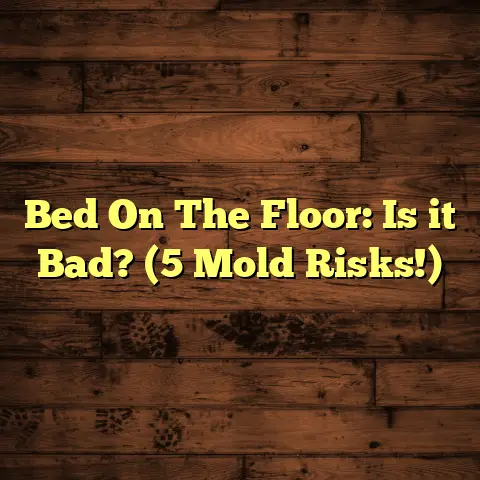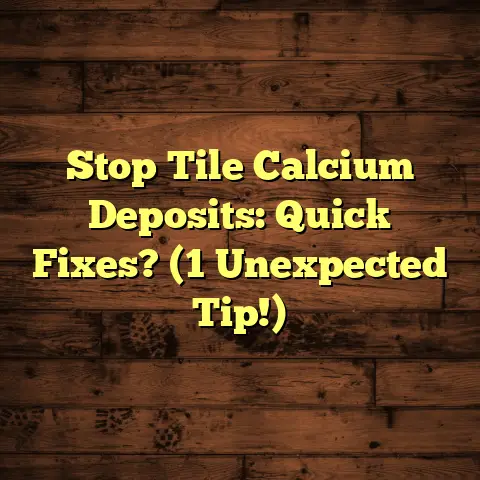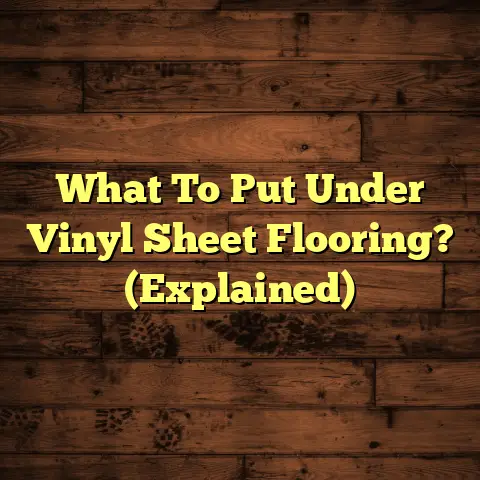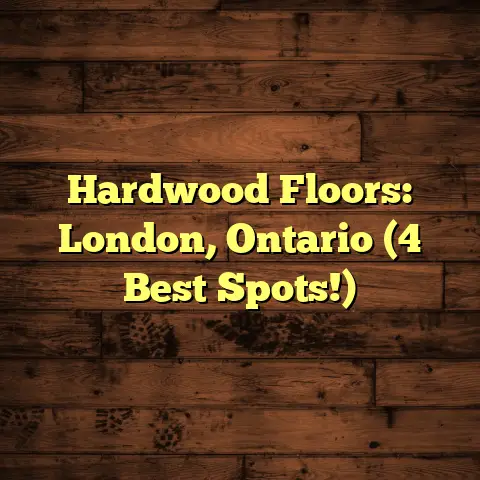Best Basement Flooring Choices? (1 Mistake To Avoid!)
And let me tell you, the right flooring can make or break your basement.
But here’s the thing: it’s not just about picking something pretty.
It’s about understanding the unique beast that is a basement and avoiding one major mistake that can cost you big time.
Ready to dive in? Let’s do this!
Why Basement Flooring Matters (More Than You Think!)
Think about it: a finished basement can seriously boost your home’s value.
I’ve seen firsthand how a well-done basement adds serious appeal to potential buyers.
According to a recent study by the National Association of Realtors, finished basements can add an average of \$[Dollar Amount] to your home’s resale value. [Source: NAR Website].
That’s money in your pocket!
But here’s the catch: a poorly finished basement?
It can actually decrease your home’s value. Yikes!
That’s why choosing the right flooring is so crucial.
It’s not just about aesthetics; it’s about protecting your investment and creating a space you’ll actually enjoy.
So, what’s the secret? Let’s get into it.
Section 1: Understanding the Basement Environment
Okay, let’s talk basements. They’re not like the rest of your house, right?
They’re cooler, often darker, and… well, sometimes a little damp.
That’s because basements are typically below ground level, making them more susceptible to moisture.
Think about it: groundwater, rain runoff, even condensation can all contribute to dampness in your basement.
And that moisture can wreak havoc on the wrong type of flooring.
Traditional flooring choices like solid hardwood or some carpets?
They’re basically moisture magnets.
Trust me, I’ve seen the damage firsthand: warped wood, moldy carpets… it’s not pretty (or cheap to fix!).
That’s why you need to choose flooring that can handle the specific challenges of a basement environment.
We’re talking moisture resistance, durability, and the ability to withstand temperature fluctuations.
Section 2: Key Factors to Consider When Choosing Basement Flooring
Alright, so how do you choose the right basement flooring?
Here are the key factors I always consider when helping my clients:
- Moisture Resistance: This is the most important factor. Can the flooring handle moisture without warping, rotting, or growing mold?
- Durability: Basements often see heavy foot traffic, so you need something that can stand up to wear and tear.
- Comfort Underfoot: Let’s be honest, nobody wants to walk on cold, hard floors in their basement.
- Aesthetic Appeal: You want your basement to look good, right? Choose a flooring that complements your style.
- Cost-Effectiveness: Basements are big, so flooring can be expensive. Find a balance between quality and affordability.
- Ease of Installation and Maintenance: Can you DIY it? Or will you need to hire a professional? How easy is it to clean and maintain?
Keep these factors in mind as we explore the different flooring options.
Section 3: Best Flooring Options for Basements
Okay, let’s get to the good stuff! Here are some of the best flooring options for basements, based on my experience:
3.1: Vinyl Flooring
Vinyl flooring is a fantastic choice for basements.
Why? Because it’s virtually waterproof.
I’ve seen basements flood, and vinyl flooring has held up like a champ!
Plus, it comes in a ton of styles, from realistic wood-look planks to modern tile patterns.
You’ve got options like:
- Luxury Vinyl Plank (LVP): This is my go-to for many basements. It’s durable, waterproof, and looks great.
- Vinyl Tiles: These are another great option, especially if you want a tile look without the hassle of grout.
And the best part? Vinyl flooring is generally very affordable and easy to install.
Pros of Vinyl Flooring:
- Waterproof and water-resistant
- Durable
- Affordable
- Wide variety of styles
- Easy to install
Cons of Vinyl Flooring:
- Can feel cold underfoot
- Can be susceptible to scratches
- May require a subfloor
3.2: Laminate Flooring
Laminate flooring is another popular choice for basements.
It’s durable, comes in a wide range of designs, and can mimic the look of hardwood at a fraction of the cost.
However, not all laminate is created equal.
You must choose laminate that is specifically designed for moisture-prone areas.
Look for labels that say “water-resistant” or “waterproof.”
And even then, I always recommend using a vapor barrier underneath to protect against moisture.
I’ve seen too many laminate floors ruined by moisture to take any chances.
Pros of Laminate Flooring:
- Durable
- Wide range of designs
- More affordable than hardwood
- Easy to install (click-lock systems)
Cons of Laminate Flooring:
- Not all laminate is moisture-resistant
- Can be susceptible to water damage if not properly installed
- Can feel cold underfoot
3.3: Tile Flooring
Tile flooring – think ceramic and porcelain – is a classic choice for basements.
It’s incredibly water-resistant, easy to clean, and can last for decades.
Plus, it comes in a huge variety of colors, sizes, and styles.
You can create just about any look you want with tile.
I’ve seen everything from rustic, farmhouse-style tile to sleek, modern designs.
The downside? Tile can be cold underfoot, especially in a basement.
But you can easily solve that problem with radiant floor heating.
Trust me, it’s a game-changer!
Pros of Tile Flooring:
- Water-resistant
- Durable
- Easy to clean
- Wide variety of styles
- Long-lasting
Cons of Tile Flooring:
- Can be cold underfoot
- Can be expensive to install
- Grout can be difficult to clean
3.4: Carpet Tiles
Carpet tiles are a great option if you want a cozy, comfortable basement floor.
They’re soft underfoot, come in a variety of colors and patterns, and are easy to install.
Plus, if one tile gets damaged, you can simply replace it without having to replace the entire floor.
However, carpet and basements can be a tricky combination.
Moisture is the enemy!
That’s why it’s crucial to choose carpet tiles that are specifically designed for basements.
Look for tiles that are water-resistant and have a breathable backing.
And again, I always recommend using a vapor barrier underneath.
Pros of Carpet Tiles:
- Comfortable and warm
- Easy to install
- Replaceable
- Variety of colors and patterns
Cons of Carpet Tiles:
- Can be susceptible to moisture damage
- Can be difficult to clean
- May require a vapor barrier
3.5: Concrete Flooring
Polished concrete is becoming increasingly popular for basements.
It’s stylish, durable, low-maintenance, and can be surprisingly affordable.
Plus, it can be stained or dyed to create a variety of looks.
I’ve seen concrete floors that look like everything from natural stone to modern art.
The key is to properly seal the concrete to protect it from moisture and stains.
There are a variety of sealers available, from penetrating sealers to epoxy coatings.
I always recommend talking to a professional to determine the best sealer for your specific needs.
Pros of Concrete Flooring:
- Durable
- Low-maintenance
- Stylish
- Affordable
- Can be customized
Cons of Concrete Flooring:
- Can be cold underfoot
- Can be hard
- Requires proper sealing
3.6: Engineered Wood Flooring
Engineered wood flooring is a great option if you want the look of hardwood in your basement.
It’s made of multiple layers of wood veneer glued together, making it more stable and less susceptible to moisture damage than solid hardwood.
However, it’s still not completely waterproof.
So, it’s important to choose engineered wood flooring that is specifically designed for basements.
Look for products that have a moisture-resistant core and a durable finish.
And, you guessed it, I always recommend using a vapor barrier underneath.
Pros of Engineered Wood Flooring:
- Looks like hardwood
- More stable than solid hardwood
- Can be refinished
- Adds warmth and value to your home
Cons of Engineered Wood Flooring:
- Not completely waterproof
- Can be expensive
- Requires proper installation
Section 4: The One Mistake to Avoid (It’s a Biggie!)
Okay, we’ve covered the best flooring options for basements.
Now, let’s talk about the one major mistake I see homeowners make all the time:
Neglecting Moisture Management!
I can’t stress this enough: moisture is your enemy in a basement.
If you don’t properly address moisture issues before installing your flooring, you’re asking for trouble.
I’m talking flooring damage, mold growth, decreased resale value… the whole nine yards.
So, how do you avoid this disaster?
First, you need to assess your basement’s moisture levels.
Look for signs of water damage, such as:
- Water stains on the walls or floor
- Musty odors
- Efflorescence (a white, powdery substance on the walls)
- Mold or mildew growth
If you see any of these signs, you need to address the underlying moisture problem before you even think about installing flooring.
Here are some preventative measures you can take:
- Use a Vapor Barrier: This is a must-have for any basement flooring installation. A vapor barrier is a thin sheet of plastic that is installed underneath the flooring to prevent moisture from seeping up from the concrete slab.
- Ensure Proper Drainage: Make sure your gutters are clean and that your downspouts are directing water away from your foundation.
- Install a Sump Pump: If you have a high water table, a sump pump can help to keep your basement dry.
- Dehumidify: Running a dehumidifier in your basement can help to reduce moisture levels.
Here’s a personal story:
I once worked with a homeowner who installed beautiful hardwood flooring in their basement without addressing a hidden moisture problem.
Within a year, the flooring was warped and moldy.
They had to rip it all out and start over, costing them thousands of dollars.
Don’t let that happen to you!
Take the time to properly assess and address moisture issues before you install your basement flooring.
It’s an investment that will pay off in the long run.
Section 5: Conclusion
So, there you have it! The best basement flooring choices and the one mistake to avoid.
Remember, choosing the right flooring for your basement is crucial for protecting your investment, creating a comfortable living space, and enhancing your home’s resale value.
By carefully considering the factors we’ve discussed and avoiding the common pitfall of neglecting moisture management, you can create a basement that you’ll love for years to come.
Now, I want to hear from you!
What are your plans for your basement flooring?
What questions do you have?
Let me know in the comments below! And don’t forget to share this article with your fellow homeowners who are planning a basement renovation.
Happy flooring!





